Hercules Cluster (Messier 13)
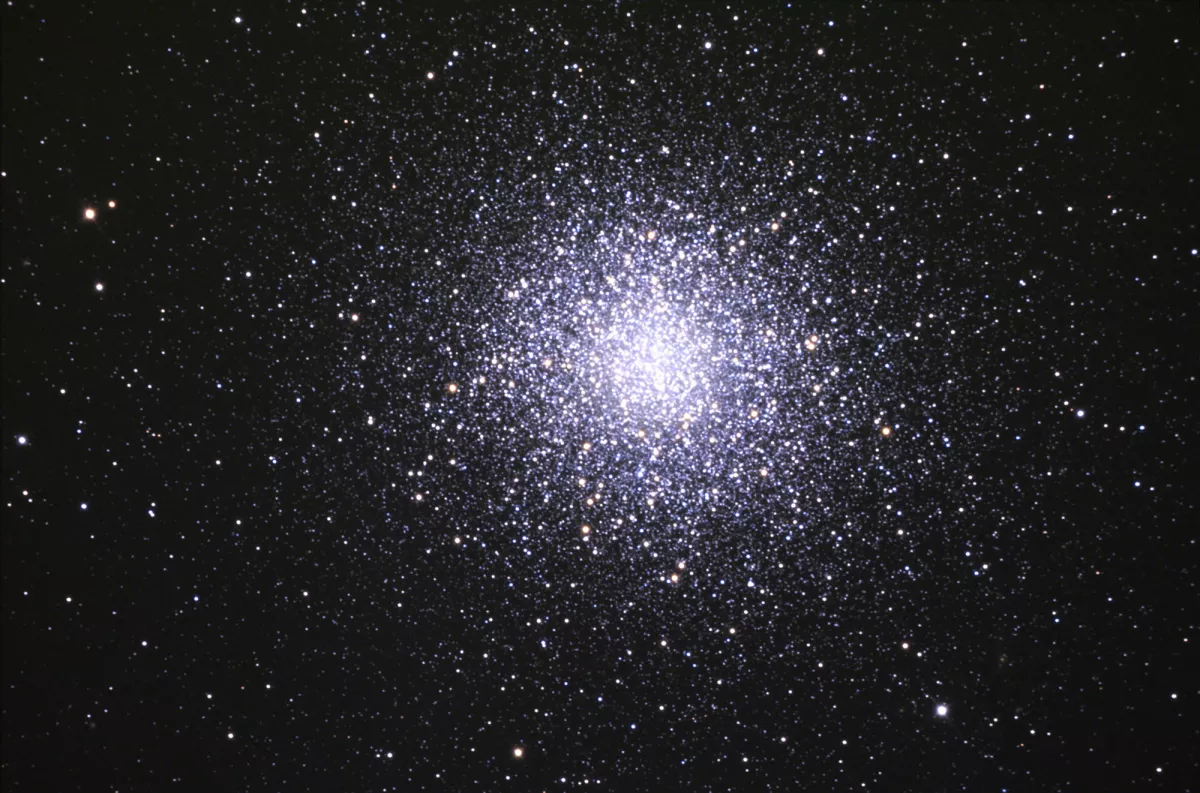
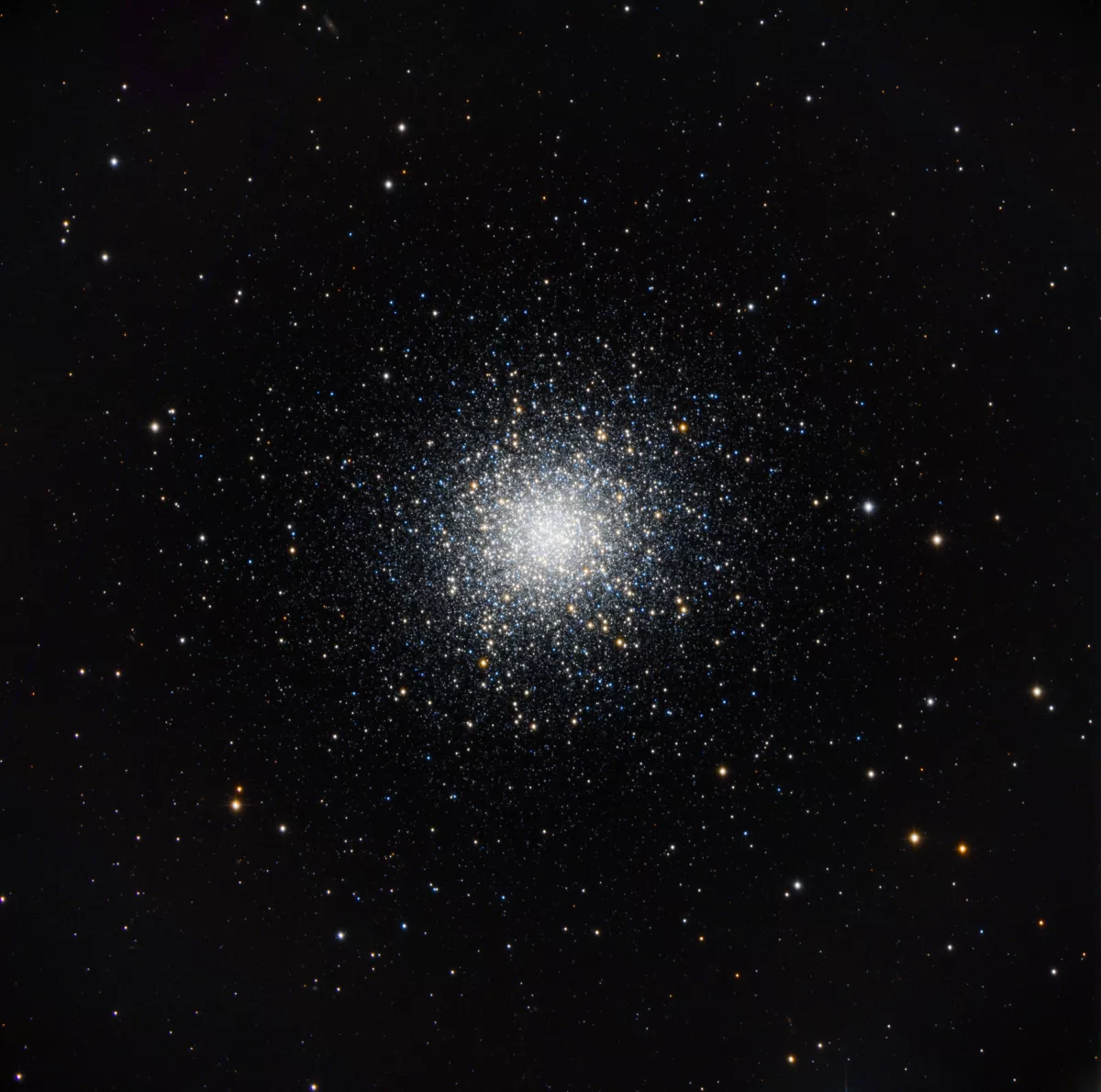
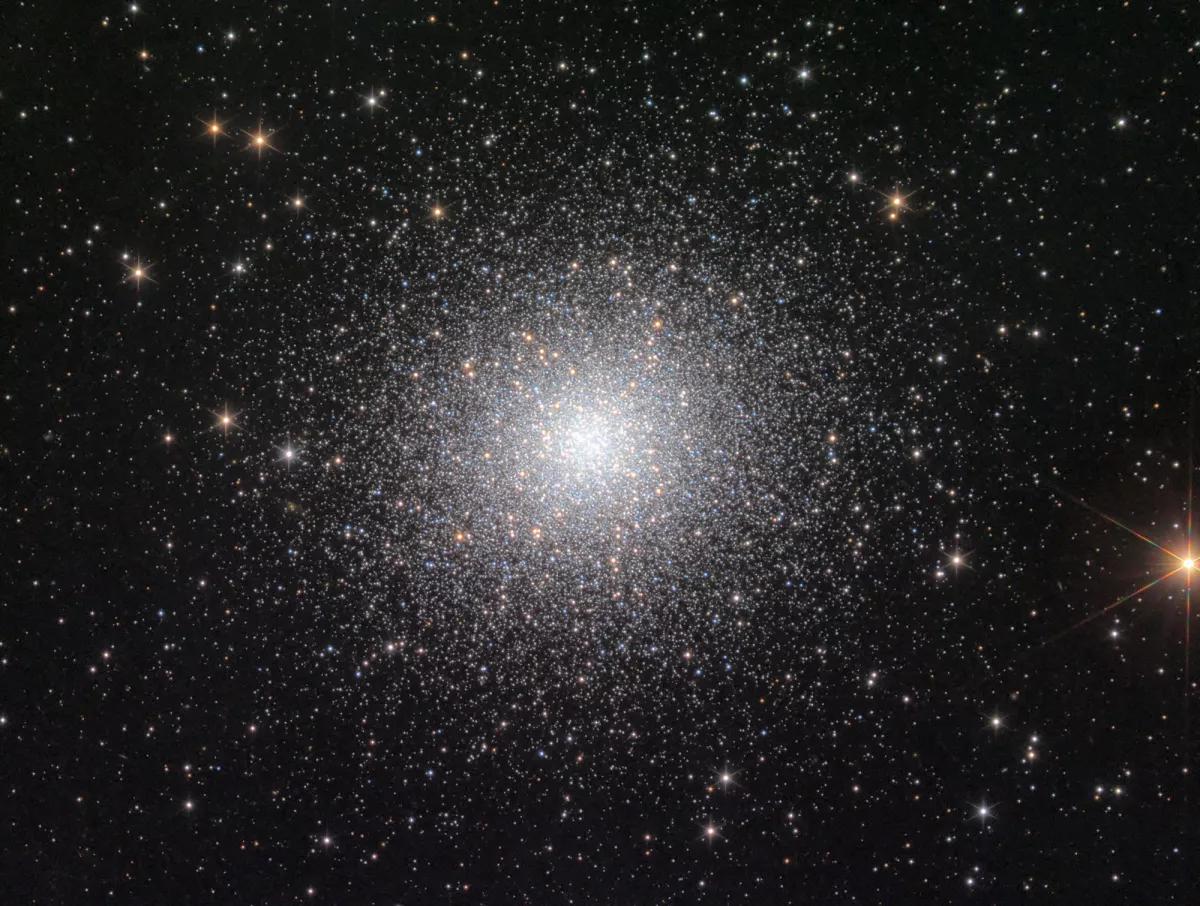
History
The globular cluster Messier 13 is one of the most beautiful in the northern sky. It was first mentioned in 1715 by Edmund Halley when he discovered it the previous year. Charles Messier listed it in 1764 as the 13th comet-like object and described the globular cluster as a round nebula with no stars in it.
Physical Properties

M 13 contains more than 30'000 stars brighter than 21st magnitude. Many cannot be counted at all because they are too close together in the center and appear as a single glowing mass on images. But the total number of stars cannot be more than a million. M 13 shines over 300'000 times brighter than the sun and its mass is possibly around half a million solar masses. The brightest members of this cluster are red giants of the 11th size class. Each of these stars is about 2000 times brighter than the sun. For comparison: The sun at the same distance as M 13 would appear to us just 19 mag bright. The integrated visual brightness of the star group is +5.7 mag, the absolute about -8.7 mag.
The integrated spectral type of the Hercules globular cluster is approximately F5. With the exception of one star of type B2, whose affiliation to M 13 is still uncertain, no blue giants are known in this system. Clusters like these are classified as pure Population II systems. A few small scraps of dark nebulae appear to be present, but it is not yet certain whether these, if real, actually belong to the cluster. They appear as small, irregular, dark spots and stripes in the core area of M 13. Three of these stripes meet on the southeast side of the central core and form a Y-shaped figure, which was first noticed by Lord Rosse. Also of interest is a large X made up of two star chains in the central area of M 13.

Few variable stars were discovered in M 13. Other globular clusters have hundreds of them. The reason for this difference has not yet been clearly determined. Four variables of the RR-Lyrae type with the apparent magnitude of 14.6 mag, three Cepheids with a longer period and a few long-period, pulsating red stars of the Mira type were identified in M 13.
The distance from M 13 is given with values of 21'000 to 32'000 light years. Spectroscopic studies showed that the globular cluster is approaching the solar system at around 240 km/s. This speed is composed of at least three different movements: the rotation of the galaxy, the movement of the sun through space and the movement of the cluster itself around the center of the Milky Way. At the moment M 13 is about the same distance from the galactic center as we are, about 30'000 light years. The period of a galactic orbit is about 200 million years.
The diameter of the Hercules globular cluster is about 160 light years. The exact shape is somewhat uncertain because the globular cluster does not have a precisely defined edge, but the star density steadily decreases towards the outside. Most of the stars are concentrated in the core, which is less than 100 light-years across, but some of the outermost hikers spread out in a range of about 200 light-years. The true density of such a cluster is a very interesting question. Photographs give the impression that the stars in the center are so tightly packed that their surfaces seem to be touching. But this is an illusion due to the great distance of the cluster and the innumerable stars it contains. The central region covers an area of about 100 light years, roughly a million cubic light years in volume. Assuming there are a million stars in the central region, there would be about one star per cubic light year. In the center itself, the density can be a few times greater, but in no case would there be a crowd there. [4, 104]
| Designation | NGC 6205 |
| Type | GCL (V) |
| Right Ascension (J2000.0) | 16h 41m 41.5s |
| Declination (J2000.0) | +36° 27' 39" |
| Diameter | 20 arcmin |
| Visual magnitude | 5.8 mag |
| Metric Distance | 7.100 kpc |
| Dreyer Description | !! globular, eB, vRi, vgeCM, st 11… |
| Identification, Remarks | h 1968; GC 4230; M 13; GCL 45; Hercules cluster |
Arecibo Message for M 13

On the occasion of the inauguration of the newly revised and improved 305 m Arecibo radio telescope in Puerto Rico, the message shown in fig. 6 of 23x73 = 1679 binary characters was sent in the direction of the globular cluster M 13 in 1974, carrier frequency 2.38 GHz, or 12.6 cm wavelength. The transmission only takes three minutes at around 20 trillion watts EIRP effective transmission power, which is brighter than the sun at this frequency. The message was compiled by Frank Drake and Carl Sagan and contains the following information to potential extraterrestrial civilizations in M 13: binary numbers 1-10 (white); Atomic numbers of hydrogen, carbon, nitrogen, oxygen and phosphorus (purple); Chemical formulas for sugars and bases of the nucleotides of DNA (green); Number of nucleotides in human DNA (white); Double helix of DNA (blue); Population of the earth (white); man (red); Size of the person (blue / white); Solar system with earth shifted towards humans (yellow); Arecibo Telescope (purple); Diameter of the telescope. Whether in about 24'000 years, when the message arrives at M 13, an extraterrestrial astronomer will have pointed his radio telescope at Earth during these three minutes and can thus receive the message, remains questionable. [2]
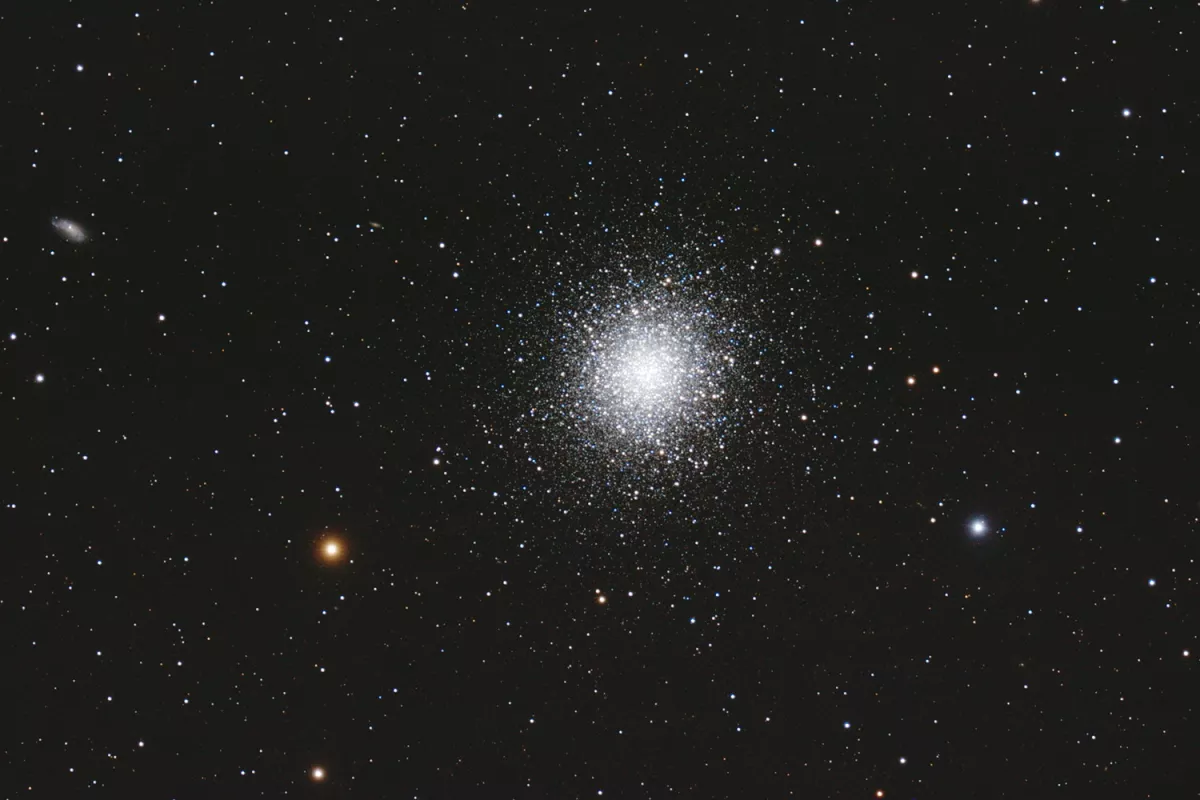
Galaxies NGC 6207 and IC 4617
From our perspective, not far from the globular cluster M 13, there is the galaxy NGC 6207. It measures 180x66 arc seconds and has an integrated brightness of 11.6 magnitudes. The surface brightness is 12.8 mag. The galaxy seems more elliptical to us, but it is actually a spiral galaxy that we see at an angle of 68 degrees. NGC 6207 moves away from the Local Group with a radial velocity of 990 km/s, which equates to a distance of 43 million light years with a Hubble constant of 75 km/s/Mpc. The galaxy appears to have a very bright core, but it is said to be a foreground star. [134]
IC 4617 is a small, faint galaxy that has often been overlooked. In Dreyer's second index catalog it is described as «small, longitudinal alignment according to PA 29° brighter center»; In the Principal Galaxies Catalog it is completely absent, only in the Hubble Guide Star Catalog it is listed as a non-stellar object of 14 mag. [134]
| Name | RA | Dec | Type | bMag | vMag | B-V | SB | Dim | PA | z | D(z) | MD | Dreyer Description | Identification, Remarks |
|---|---|---|---|---|---|---|---|---|---|---|---|---|---|---|
| NGC 6207 | 16 43 03.7 | +36 49 55 | Gx (Sc) | 12.2 | 11.6 | 0.6 | 13.0 | 3 × 1.2 | 15 | 0.002842 | 12.00 | 19.180 | pB, pL, E 45° ±, vgmbM | WH II 701; h 1969; GC 4231; UGC 10521; MCG 6-37-7; CGCG 197-7; IRAS 16412+3655; KARA 766; KUG 1641+369 |
| IC 4617 | 16 42 08.1 | +36 41 03 | Gx (Sb) | 16.0 | 15.2 | 0.8 | 14.3 | 1.2 × 0.4 | 32 | 0.036502 | 154.1 | S, E 29°, bM |
Finder Chart
The globular cluster M 13 is very easy to find. As the figure shows, the telescope must be aligned on the western side of the Hercules trapezoid, on the line from eta to ζ Herculis, about a third of the distance closer to the star η Herculis. The globular cluster is already clearly visible in the finderscope.
27 arc minutes northwest of M 13 lies the galaxy NGC 6207, which, at small magnifications, appears in the same field of view as M 13. Halfway between M 13 and NGC 6207 is the small, faint galaxy IC 4617. It lies west of a small, striking parallelogram made up of four 14 mag stars.
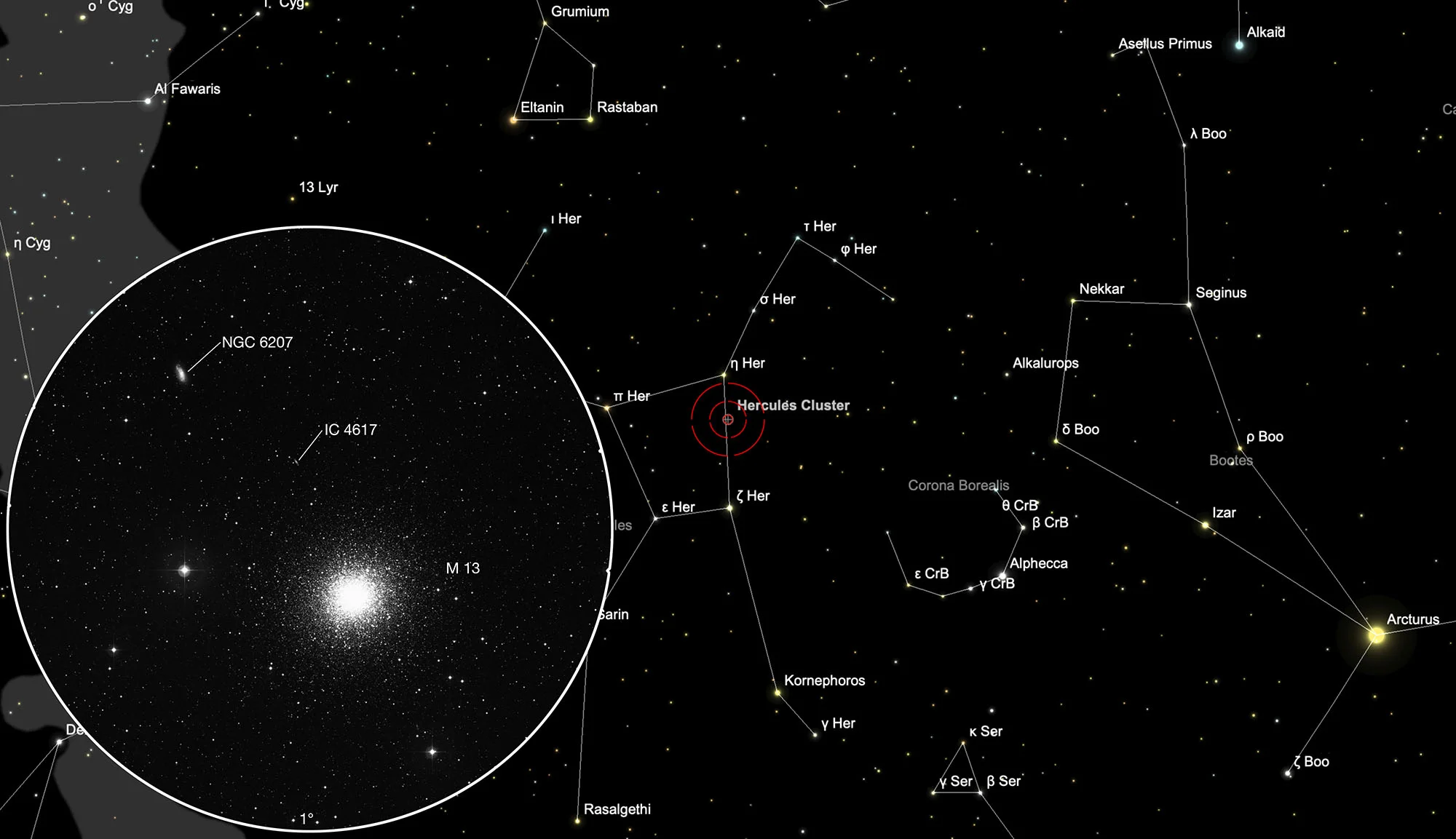
Visual Observation
Naked Eye: On the rare, clear and dark nights away from the light-infested Swiss plateau, the globular cluster M 13 is also clearly visible to the naked eye; to do this, however, it must be fully dark-adapted. If you look past the position of M 13, which is called «indirect vision», the globular cluster reveals itself as a small, weak, diffuse spot. Single stars are of course not yet recognizable. — 1999, Bernd Nies
Binoculars to medium-sized telescopes: In medium-sized binoculars, the globular cluster appears slightly granulated and is partially resolvable at the edge areas. A smaller telescope can fully resolve the globular cluster. The view becomes overwhelming in medium-sized telescopes with high resolution. You have the feeling of being completely immersed in the thousands of stars. Yes, there is almost a three-dimensional effect with the bright stars in the foreground and increasingly weaker ones in the background. — 14" PWO-Dobson, F:4.6 / TV-Nagler-Zoom 6mm-3mm, 266x-533x, 0.19°-0.09°
— Eduard von Bergen
400 mm Aperture: The globular cluster M 13 is an easy one to find and always a magnificent sight, not only to the untrained eye. From low to higher magnifications it offers a feast for the eyes, as if someone has poured out a large pile of brilliants on a black velvet cloth. — 400 mm f/4.5 Taurus Dobsonian, Glaubenberg, 17. 6. 2023, Bernd Nies